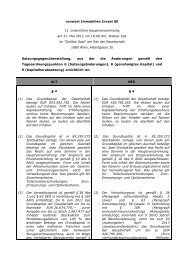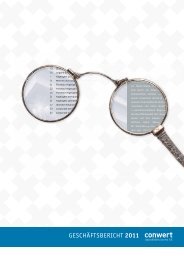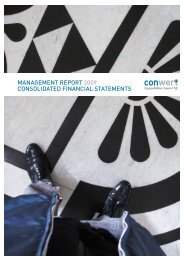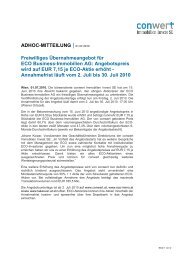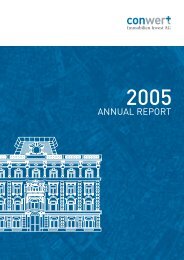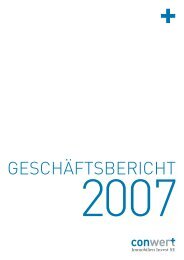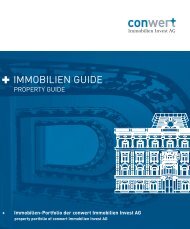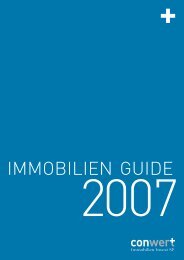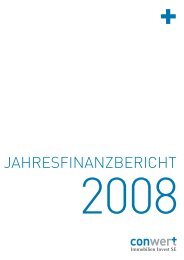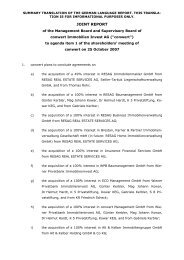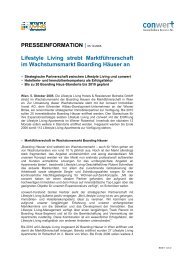annual financial statement 2011 - conwert Immobilien Invest SE
annual financial statement 2011 - conwert Immobilien Invest SE
annual financial statement 2011 - conwert Immobilien Invest SE
Create successful ePaper yourself
Turn your PDF publications into a flip-book with our unique Google optimized e-Paper software.
CONWERT IMMOBILIEN INVEST <strong>SE</strong><br />
ANNUAL FINANCIAL <strong>2011</strong> STATEMENT ANNUAL REPORT <strong>2011</strong><br />
94<br />
8.10. FINANCIAL INSTRUMENTS<br />
8.10.1. FINANCIAL AS<strong>SE</strong>TS<br />
Non-current <strong>financial</strong> assets consist primarily of shares in Vienna Estate <strong>Immobilien</strong> AG, an<br />
Austrian property holding company, and shares in CD Deutsche Eigenheim AG, a German property<br />
company, which are classified as available for sale and carried at cost.<br />
Trade accounts receivable (less impairment charges recognised as of 31 December <strong>2011</strong>) total<br />
€ 30.9 million (2010: € 56.8 million) and comprise receivables from the sale of objects and shares<br />
in properties as well as rents receivable and receivables due to the property, management and<br />
property service companies.<br />
The purchase prices for shares in properties are generally paid without delay, and impairment<br />
charges are therefore not recognised. The agreements for the sale of buildings and property<br />
companies call for payment when the title is transferred or short-term payment with settlement<br />
through a trustee. Therefore, impairment charges are not recognised to these items.<br />
Trade accounts receivable are related to the rental business and do not normally have specific<br />
payment terms. The recognition of impairment charges to these items is based on experience with<br />
default.<br />
Rents receivable of € 14.1 million (2010: € 16.3 million) were adjusted through impairment charges<br />
to reflect any loss in value as of the balance sheet date. The <strong>conwert</strong> Group holds deposits of<br />
€ 1.5 million (2010: € 1.9 million) as security for these outstanding items. Overdue receivables do<br />
not represent a material valuation risk for the Group.<br />
The following tables show the age structure of rents receivable for <strong>2011</strong> and 2010 that were not<br />
reduced through impairment charges:<br />
<strong>2011</strong><br />
in € million<br />
Up to 30<br />
days<br />
The changes in impairment losses are as follows:<br />
30 to 60<br />
days<br />
60 to 90<br />
days<br />
90 to 120<br />
days<br />
Over 120<br />
days<br />
Austria, Germany, CEE 7.5 0.9 0.2 0.8 9.7<br />
2010<br />
in € million<br />
Up to 30<br />
days<br />
30 to 60<br />
days<br />
60 to 90<br />
days<br />
90 to 120<br />
days<br />
Over 120<br />
days<br />
Austria, Germany, CEE 9.8 0.9 0.6 1.0 11.5<br />
in € million <strong>2011</strong> 2010<br />
Balance as of 1 January 7.5 3.0<br />
Impairment of receivables – addition 2.2 5.7<br />
Derecognition to reflect non-collectability / reversal to reflect payment 4.6 1.2<br />
Balance as of 31 December 5.1 7.5<br />
The impairment testing of rents receivable also includes any changes in the credit standing of<br />
tenants as of the relevant balance sheet date. Only individual adjustments are recognised. There is<br />
no material concentration of credit risk because the Group has a very broad tenant base and there<br />
is no concentration or correlation. Management is therefore convinced that no provisions for risk<br />
are required above and beyond the previously recognised impairment losses.



